

To proceed with the third step the knowledge from step two is indispensable, but apart from that step three is not really difficult.
The tactics issues are relatively easy and also the lessons about defending against tactics should not cause any problems. Only trapping is a bit tricky. It can be compared to mating but now instead of the king another piece is the victim.
Furthermore, attention is being paid to the first pawn endgames. For some students it is a child's play but for those who have still problems with the control of space it is a tough struggle.
In this step we begin to teach the supporting skills. One of them is 'thinking ahead'. The student calculates in his head the possibilities and visualizes ( tries to imagine) the new situation which arises on the chess board. The command of this skill can differ enormously per student
'The third step' consists of a manual and workbooks.
• Manual for chess trainers Step 3
• Workbook Step 3 thinking ahead
Download excerpts of each book: Samples
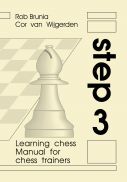
Contents:
Introductory articles about:
Then the 17 lessons follow:
1: Completing the opening
2: Discovered and double check
3: Attacking a pinned piece
4: Mate after gaining access
5: The square of the pawn
6: Eliminating of the defence
7: Defending against a double attack
8: Mini-plans
9: Draws
10: X-ray
11: The opening
12: Defending against a pin
13: Mobility
14: Key squares (1)
15: Pinned pieces
16: Threats
17: Key squares (2)
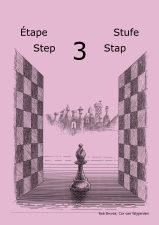
From the 5th edition onwards workbook Step 3 is published as an international version. We have decided to remove the reminders and make them available as a PDF file for downloading. This means more exercises on the pages that have become available. Step 3
There are 12 reminders.
Have a try! Mobility: trapping
The themes of the exercises correspond to those in the manual.
See the Manual for the chess trainer.
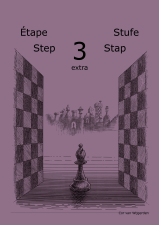
Read more about the Extra books in info.
In the extra workbook there are 54 pages with exercises, which means as many as 54x12=648-25 (drawings) = 619 positions. At the beginning come the exercises with the familiar items from Step 3:
The last 26 pages contain tests. There is also a reminder with hints how to proceed with the tests.
Test yourself! Test step 3
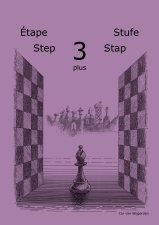
Read more about the plus books in the info.
The contents of the Workbook Step 3 plus:
More or less new topics:
Elaborating the already introduced material:
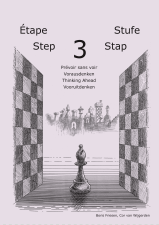
The first edition of Step 3 Thinking Ahead is a 4-language version (the previous version was only available in Dutch). More than half of the tasks has been changed or replaced compared to the previous Dutch version. The reminders are available for download as PDF files.
Step 3 Thinking Ahead).
The group of students for whom the book is useful is very broad. The first target group are those students who have worked through all the workbooks from Step 1 to Step 3 plus (including Thinking Ahead Step 2 of course). In addition, all chess players from the higher levels who have gone through all the steps too fast. They improve too slow or make no progress so they can still benefit from using this workbook.
The importance of such workbooks is increasing. Thinking ahead is an essential skill in games from the moment the opening theory stops and you have to think. Thinking ahead flawlessly is necessary throughout the game and, in fact, until the moment when you stop playing chess altogether. Practicing is therefore worthwhile.
It is remarkable that the ability of many players to think ahead without mistakes is clearly stagnating. Why? This skill is much less practiced when working with the computer. After a move, the move of the opponent comes back directly and you don't have to keep the position in mind. Being able to hold the positions in your working memory is necessary to increase your playing strength. In addition to the tasks with moves below the diagram, the blind exercises in this workbook are suited for this purpose even better.
The different exercises are more varied than in the other workbooks. The topics from Step 3 return partly. This gives an indication of what information needs to be retrieved from long-term memory. In this way a large part of the working memory is available for thinking ahead then.
Have a look at some example pages.
Step 3 Thinking ahead
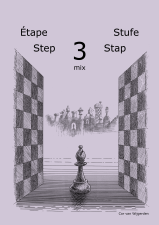
Read more about the mix books in info.
In the mix workbook are 62 pages with exercises, which means as many as 62x12=648-18 (drawings e.o) = 726 puzzles.
The theme's are known from Step 3, Step 3 plus and the lower Steps. A workbook containing exercises with one ‘simple’ assignment: play the best move. Just like in a real game, you do not know whether you can win or whether you have to defend. First, look at what’s going on? Which targets can you exploit? What is the opponent threatening? Is it time to draw? In short, all kinds of stuff.
Two kinds of puzzles are different: on each page you will find a multiple choice question and a position with a line below the diagram. Only on the last 8 pages there is an indication of the theme: 2 pages mate planners and 6 pages with mate in two problems.